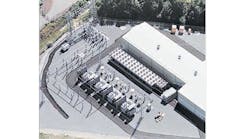Development of the new HVDC Light technology has continued at a rapid rate, with voltage levels and power ratings steadily increasing as power losses decrease. Since the first transmission ABB has undertaken 20 HVDC Light projects globally. HVDC Light is currently available for ratings of 2,000 MW / ± 500 kV in bipolar configuration and 1,200 MW / ± 320 kV in symmetrical monopolar configuration. Voltage source converter (VSC) technology provides superior dynamic features that go beyond pure power transmission. They have no reactive power demand or associated need for reactive power compensation. They appear to the network as a virtual synchronous machine but without inertia. Therefore the converters can help control the AC voltage.
A brief history
In the development of power electronic technology for industrial drive systems thyristors were replaced with VSCs where the semiconductors could be switched off as well as on. The advantages this change brought to controlling industrial drive systems could also be applied to transmission technology. The result was the development of devices with voltage and current ratings suitable for transmission. This semiconductor development formed the basis for HVDC Light.
Within five years of its inaugural project, ABB commissioned two HVDC Light commercial projects – Gotland Light in Sweden in 1999 and Directlink in Australia in 2002 – where the technology was proven at a voltage level of ± 80 kV and a power rating of 55 MW per circuit. The next step was the introduction of systems at the ± 150 kV level. A power rating of 330 MW was reached in 2002 with the Cross- Sound Cable (CSC) project connection in New Haven and Long Island in the United States, and the 200 MW Murraylink project in Australia.
Cross-border trading
With the CSC project, ABB showcased the ability for cross-border trading as well as excellent dynamic voltage support with HVDC Light. CSC was the first merchant transmission project in the United States consisting of a bidirectional 330 MW transmission system with two AC/DC VSC stations connected by a pair of 40 km DC submarine cables.
Transmission capacity over the CSC project was offered to market participants through an open season process and a firm capacity purchase agreement. A key feature of the HVDC Light technology in the CSC project is the ability to precisely control power transfers with scheduled transactions by those who have purchased rights to its capacity
Additional benefits for the HVDC Light technology in the project were reactive power and AC voltage control at each converter to support the connected AC networks and a compact layout with the majority of all equipment inside the converter building. Modular design allowed for comprehensive factory testing, which led to short field testing and commissioning.
The cross-border trading feature in this instance works well because the operator can continuously control the power transfer in either direction between 0 and 330 MW independent of the AC voltage control. CSC manages the steady-state AC voltage regulation at the connecting stations to improve the dynamic stability. During the first year of operation a testimony to the quality of the feature was seen when a severe thunderstorm on Long Island created multiple AC faults, yet voltage up to its reactive power limit of 125 MVAr was supported and active power kept relatively constant.
Following the massive blackout of the northeastern portion of North America on August 14, 2003, CSC was instrumental in restoring electric power to customers on Long Island, being one of the first transmission links to the area brought into service after the blackout. The link transported 330 MW to the area, enough power to restore electric service to over 330,000 homes. Furthermore, CSC's AC voltage control feature proved valuable by stabilizing the AC system voltage in Connecticut and on Long Island during the network restoration.
Estlink 1
Supply security and black-start capability are additional benefits ABB has provided with HVDC Light. The Estlink 1 transmission system, operating at 350 MW / ±150 kV DC, has been able to provide these features while connecting the national grids of Estonia and Finland. Commissioned in December 2006, this was the first time electric power was exchanged between the Baltic states and the Nordel electric systems. With the goals of creating electricity trading and increasing secure supply in the Baltic region, HVDC Light was an obvious choice due to the asynchronous networks and the long distance under water between the two systems.
Both interconnected networks benefit from active and reactive power control and AC voltage control. Additional control features are emergency power control, frequency control and rapid active power flow to support either of the connected grids. On the Finnish side a damping control is designed to damp the inter-area oscillations that can occur in the Nordel electric system to increase operational security.
HVDC Light converters are able to generate a voltage that can be changed very quickly in amplitude and phase and offer the possibility of energizing a network after a blackout. This has been implemented in Estlink 1 for the Estonian side.
The transformer is equipped with a special auxiliary power winding for self-supply of the converter station, and the control system has schemes for detecting a network blackout. If such a blackout occurs, the converter will automatically trip the connection to the grid, and continue to operate in supplying its own auxiliary power, supplied through the DC from the Finnish station. The converter can also be started manually in blackstart mode, if needed.
The network restoration sequence starts with the converter station running without load. The voltage and frequency are decided by the converter, which in this case operates in voltage and frequency control. The AC network is then connected with a small load, and ramped up to the rating of the link. The black-start feature makes it possible to start up parts of the Estonian network in only minutes after a total blackout. In the network restoration scenarios determined by the grid operator, Estlink 1 would provide auxiliary power to selected power units. Estlink 1 and the connected generators will share the load through the use of frequency droop. When a sufficient amount of generation is feeding the network, the mode of operation of the converter can be changed from frequency/voltage control to normal power/voltage control.
Caprivi Link
Many of the electricity networks in the developing part of the world, such as Africa, span vast distances and are often characterized by relatively weak AC networks. ABB's Caprivi Link project 1 was able to meet these challenges in order to connect the Zambezi converter station in the Caprivi strip in Namibia, close to the border of Zambia, and the Gerus converter station, about 300 km north of Windhoek in Namibia. The Caprivi transmission link is a 2 × 300 MW interconnection with the converter stations joined by a 950 km long, bipolar ± 350 kV DC overhead line. This was the first HVDC Light project to combine VSCs with overhead lines.
The weak networks have a high likelihood of becoming islanded with passive AC networks when critical lines are tripped. The converter controllability with AC voltage and frequency control prevents tripping of about 100 MW of generation at Victoria Falls island close to the Zambezi converter. A similar condition can occur on the Namibian side when the AC link to South Africa is lost and the Gerus converter station islands together with the Ruacana hydropower station. Similarly both sides can experience passive network conditions where no generation is present. Without the HVDC Light link the outage of critical lines can lead to a blackout due to the extremely weak AC network.
The HVDC Light solution has enhanced stability and assisted with the prevention of blackouts. The Caprivi Link converter stations can provide up to ± 200 Mvar reactive power capability throughout nearly the entire power transfer range from 0 to 300 MW. The solution is prepared for providing n-1 network security when the full bipole is implemented. During a DC line fault, the converter stations are temporarily isolated from the AC grid and the DC line by opening the AC and DC circuit breakers to interrupt the fault currents. Immediately after clearing the fault currents, the breakers are re-closed and the transmission resumed. Reactive power support is resumed within 500 ms and power transmission within 1,500 ms.
Integration of onshore renewable generation
HVDC Light transmission technology is of particular interest for power transfer between asynchronous AC grids in order to increase the security of supply between grids with wind farm generation. The EirGrid East-West Interconnector project (EWIP), is a benchmark example. Commissioned in 2012, EWIP links the high-voltage power grids of Ireland and Great Britain by means of an HVDC Light interconnection. The project is ABB's most recent, and largest HVDC Light project undertaken.
Ireland is expanding its wind power generation and the 500 MW / ± 200 kV EWIC HVDC Light transmission system provides an opportunity to export excess power into the UK market.
Additional customer benefits, due to the choice of the HVDC Light technology, are the system's black-start capability and active AC voltage support. In addition, by connecting to the UK national grid, Ireland can now access power from continental Europe (via an interconnector from Great Britain to the continent).
As part of the solution, ABB extended the previous rating record for an HVDC Light cable from 150 kV to 200 kV. The higher voltage enables a higher transmission capacity of 500 MW.
DOWNLOAD THE FULL VERSION [PDF]
Peter Lundberg
ABB Power Systems, Grid Systems
Ludvika, Sweden
[email protected]
Mike Bahrman
ABB Power Systems, Grid Systems
Raleigh, NC, United States
[email protected]


